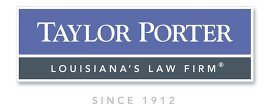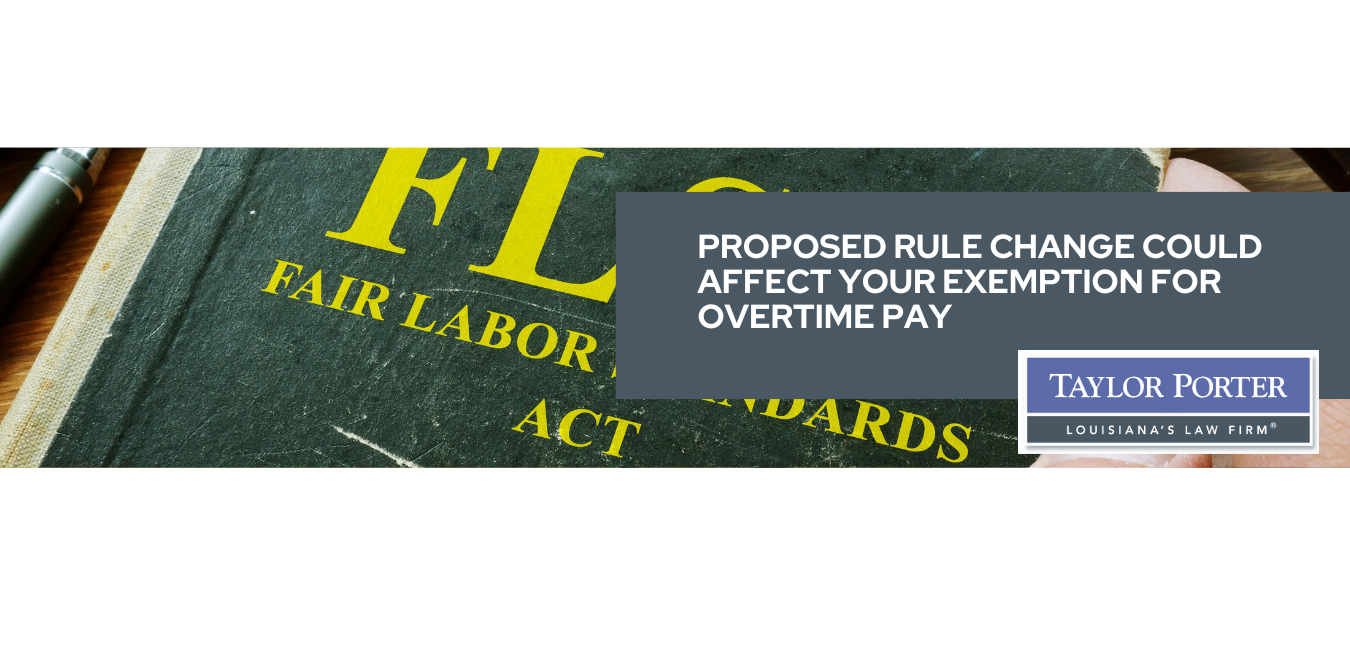“What’s In The (Trump) Cards?” - Healthcare L&E Issues in Limbo Under New Administration
Article Published in May/June 2017 Issue of Healthcare Journal of Baton Rouge
By Tom Peak
Partner, Taylor Porter
tom.peak@taylorporter.com
 In the 2008 movie, “21,” an unorthodox math professor at M.I.T. (played by Kevin Spacey) recruits six students and trains them to become experts in card counting in order to “win big” in Las Vegas at the blackjack tables. The movie was based on fact, and the card counting method depicted has been, and is utilized in casinos on a regular basis. Card counting is a casino game strategy utilized to determine whether the next hand is likely to give an advantage to the player or the dealer, by keeping a running tally, or “count” of all “high” and “low” cards in the multi-deck “shoe.” The count becomes more “accurate”, and therefore valuable, as more cards are removed from the “shoe.” In “21” members of the team would monitor shoes, and count cards, at several tables, signaling the “high roller” player to join the table when the count became more/most favorable to the player. If one considers President Trump’s campaign and present term in office to be the “shoe,” we are obviously not deep enough into the “shoe” (yet) to get a definitive “count.” Nevertheless, by watching as the Trump cards continue to be dealt, employers can make better decisions going forward…betting cautiously at first, but with some sense of what the next cards will likely be. As players at the “Trump Casino,” employers should be watching the following developing areas, in order to get a more accurate count and improve their odds.
In the 2008 movie, “21,” an unorthodox math professor at M.I.T. (played by Kevin Spacey) recruits six students and trains them to become experts in card counting in order to “win big” in Las Vegas at the blackjack tables. The movie was based on fact, and the card counting method depicted has been, and is utilized in casinos on a regular basis. Card counting is a casino game strategy utilized to determine whether the next hand is likely to give an advantage to the player or the dealer, by keeping a running tally, or “count” of all “high” and “low” cards in the multi-deck “shoe.” The count becomes more “accurate”, and therefore valuable, as more cards are removed from the “shoe.” In “21” members of the team would monitor shoes, and count cards, at several tables, signaling the “high roller” player to join the table when the count became more/most favorable to the player. If one considers President Trump’s campaign and present term in office to be the “shoe,” we are obviously not deep enough into the “shoe” (yet) to get a definitive “count.” Nevertheless, by watching as the Trump cards continue to be dealt, employers can make better decisions going forward…betting cautiously at first, but with some sense of what the next cards will likely be. As players at the “Trump Casino,” employers should be watching the following developing areas, in order to get a more accurate count and improve their odds.
The Affordable Care Act (“Obamacare”)
According to the Bureau of Labor Statistics, the Healthcare Industry added approximately 1 million jobs since the Obamacare exchanges and Medicaid expansion went into effect in 2014 (259,200 jobs in 2014; 438,800 jobs in 2015; and 296,400 jobs in 2016). Employee compensation costs (pay and benefits, including health insurance) grew at rates between 7% and 10%, outpacing revenue growth. More employees were needed (and hired) in order to address (and handle) the influx of newly insured patients under Obamacare. The pace of hiring has slowed, as concerns over Obamacare’s fate grew, with exchange failures and an “insurer exodus” from certain exchanges, and as the Trump campaign (and Republicans in Congress) promised to “repeal and replace” Obamacare. True to their campaign promises, an effort to “repeal and replace” Obamacare was made in Congress, but the Bill subsequently was withdrawn in the face of criticism from both the Democrats… and the conservative Republicans. After withdrawal, it appeared that the Trump administration would shift its focus to tax reform and infrastructure, allowing Obamacare to collapse under its own weight. However, it now appears that the effort to “repeal and replace” is “not dead yet” (with apologies to Monty Python), due to the reliance on predicted resulting savings to free up space for tax reform and reduction of existing tax rates.
Overtime Pay Exemption Minimum Salary Levels
The Department of Labor’s planned change to the Fair Labor Standards Act (FLSA) overtime regulation, roughly doubling the existing minimum salary requirement to $47,476 a year, was scheduled to go into effect on Dec. 1, 2016, before inauguration. The Trump campaign was critical of the change, and twenty-one states and dozens of business groups sued, seeking to block the rule change from taking effect. On Nov. 22, 2016, a federal judge in Texas issued a preliminary injunction blocking implementation of the rule change. While a final decision has not been rendered in this litigation (Nevada, et. al., vs. Department of Labor), it appears unlikely that the new increased salary levels will go into effect, at least in their present form, as President Trump does not support them, his Department of Labor will not defend them, and the courts may permanently block them. Regardless of the courts’ decision on appeal, the Trump Administration and DOL will likely rescind or revise the regulations.
Minimum Wage
The $7.25 per hour federal minimum wage rate has been in effect since 2009. During the campaign, President Trump indicated that he would consider raising the minimum wage to $10 per hour, but also stated that American wages were generally “too high.” With Trump’s victory resting in large part on the support of working class voters, and with the passage of time since the last increase in the federal rate, it would seem that some increase would be likely. On the other hand, President Trump’s reported statements that such action should be at the “state level” leaves open the possibility that no increase (in the federal rate) will take place, at least in the short term.
Employment-Related Immigration
U.S. Citizenship and Immigration Services recently released a new “guidance” that computer programmers are no longer presumed to be eligible for H-1B visas, describing the guidance as a “clarification,” rather than a “policy change.” In addition, the USCIS announced new measures to rein in “abuse” of the H-1B program. These “cards” indicate the Trump administration intends to make good on its promise to address fraud and abuse of the H-1B program, and will focus on reserving these temporary employment visas for very high-skilled (and higher paid) professionals, while encouraging lower- and middle-level jobs to go to American workers. There may also be more restrictions on the J-1 (exchange visitor) visa program and TN (NAFTA Professionals) visa programs, as these programs are believed (by some) to have an adverse impact upon American workers and pay.
National Labor Relations Board (Unions)
President Donald Trump will soon fill the National Labor Relations Board’s two vacant seats with pro-business members. This will likely result in the Trump Board’s reversal of some of the Obama Board’s more controversial
(pro-union) rulings, which have stretched the National Labor Relations Act (NLRA) far beyond its (traditional) limits, including the following:
- Browning-Ferris – Perhaps the most controversial decision, in which the Obama Board “loosened” the standard for determining who qualifies as a “joint employer” and would share unfair labor practice liability and bargaining obligations with its contractors.
- Specialty Healthcare – In this decision, the Board upped the “ante” for employer challenges to narrow bargaining units, in an effort to assist unions in organizing at employer facilities, by requiring an employer, contesting a proposed “narrow” bargaining unit, to prove that excluded workers share “an overwhelming community of interest” with those included. Recent statistics show that this change has increased union win rates in representation elections.
- Purple Communications – A split NLRB issued this ruling, which allowed workers to use employer-provided e-mail for labor law protected purposes, such as to join or assist unions and/or engage in concerted activity for the worker’s mutual benefit. Insofar as other communication tools are readily available for employees, many believe that the Trump Board will likely revisit and reverse this ruling.
- Banner Health, D.R. Horton and Murphy Oil; and Lutheran Heritage – Other rulings which are ripe for reversal by the Trump Board are:
- Banner Health – A human resource consultant’s practice of asking employees (involved in investigations) not to discuss them with co-workers was determined to have violated the law. In order to justify confidentiality, the decision requires an employer to show a legitimate business need outweighing Section 7 rights.
- D.R. Horton and Murphy Oil – The NLRB ruled that arbitration policies, requiring employees to waive their right to pursue class actions for employment-related disputes, violate the NLRA. This class waiver issue will be considered by the Supreme Court, which may include President Trump’s nominee, Judge (Neil) Gorsuch.
- Lutheran Heritage – Under Lutheran Heritage, work rules and handbook provisions are “unlawful” if employees “would reasonably construe them” to prohibit activity protected under Section 7. The Trump Board will likely adopt a balancing test, weighing the employees’ Section 7 rights against the employer’s business justification.
Conclusion
While not very “employer friendly,” the Obama Administration was predictable with respect to employment issues. Most pundits, predicting the election of Hillary Clinton, believed that the “count” would stay steady, believing that a Clinton Administration would represent a continuation of the Obama “shoe.” President Trump’s Administration represents a new “shoe”, and employers (with some level of cautious optimism that the odds have shifted in their favor) will be watching and counting cards carefully.
About Tom Peak: Practicing law since 1984, Taylor Porter Partner Thomas R. Peak practices in labor and employment law, including employee benefits litigation (ERISA and COBRA), employment eligibility and certification (under the immigration laws), workers' compensation (representing management), and OSHA matters. He also represents clients in higher education law. He has presented seminar topics on labor and employment law, including sexual harassment, discrimination, labor certification, employment eligibility issues, family medical leave, workers compensation and Wage and Hour law for the Baton Rouge Bar Association, the National Business Institute, the Louisiana Chapter of the International Personnel Management Association, and Louisiana State University. He has authored articles in the Baton Rouge Business Report on subjects including employee privacy issues and employee payment issues.
This website is for general information purposes only. Information posted is not intended to be legal advice. For more information, please see our Disclaimer message.
See how we can help. Contact us today
8th Floor • 450 Laurel Street • Baton Rouge, LA 70801 • 225-387-3221
- Disclaimer
- © Taylor, Porter, Brooks & Phillips L.L.P. All rights reserved.






